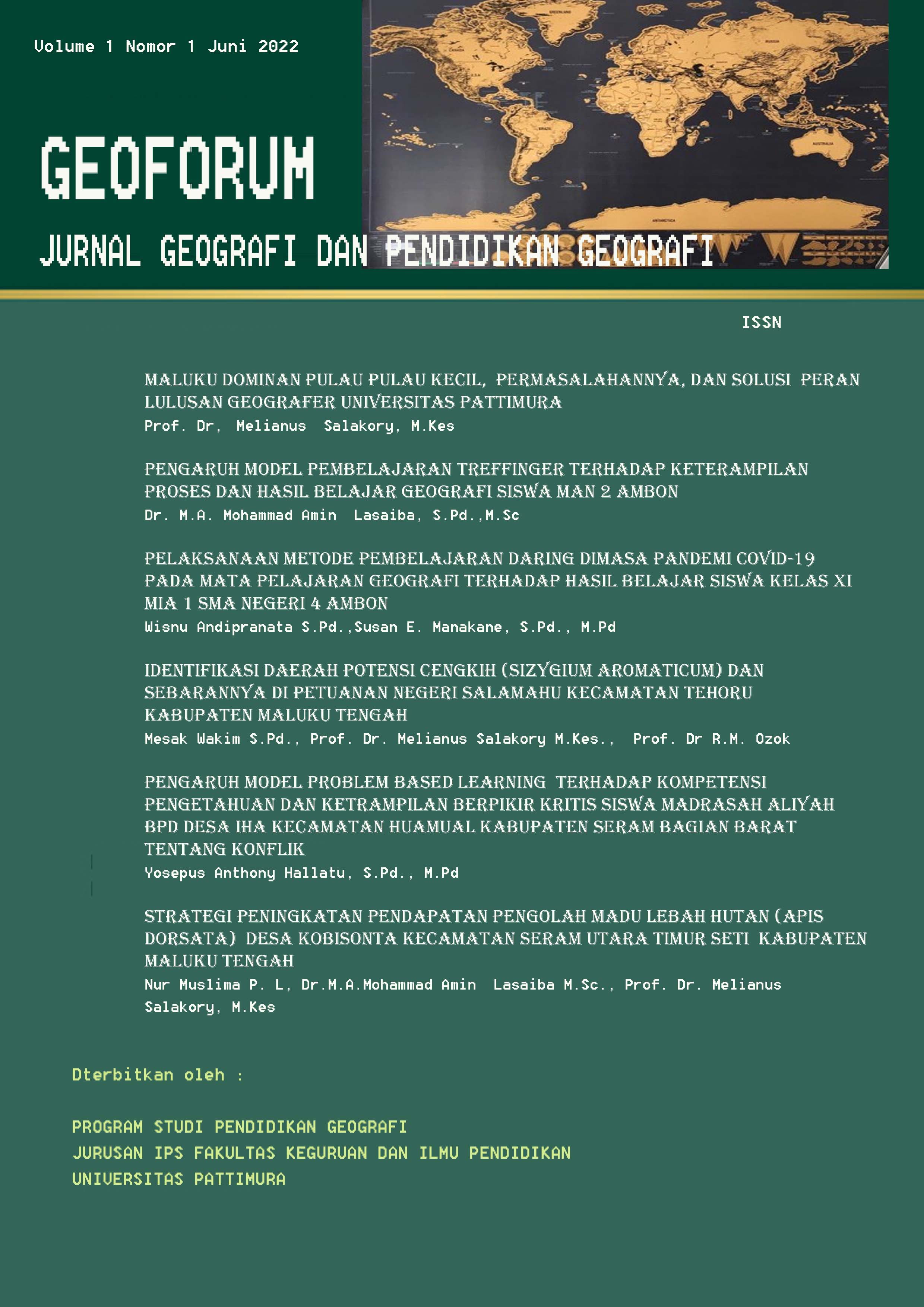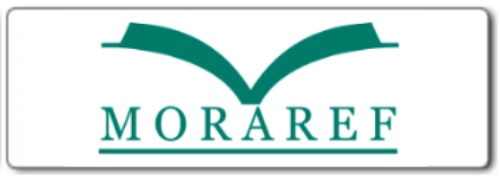Strategies for Increasing the Income of Wild Honey Collectors (Apis Dorsata) in Kobisonta Village, East Seram Seti District, Central Maluku Regency
Strategi Peningkatan Pendapatan Pencari Madu Lebah Hutan (Apis Dorsata) Desa Kobisonta Kecamatan Seram Utara Timur Seti Kabupaten Maluku Tengah
Abstract
This study examines the processing of wild honey (Apis dorsata) as a means to increase the income of the community, particularly the honey processors in Kobisonta Village, East Seram Seti District, Central Maluku Regency. The research then develops strategies for further development. The method used in this study is a mixed-method approach, combining qualitative and quantitative research. The qualitative research uses descriptive analysis, while the quantitative research employs multiple linear regression analysis to predict the effect of independent variables on the dependent variable and SWOT analysis to develop strategies for increasing the income of honey processors.
The results of the study indicate that, partially, the variables of education, business duration, and capital have a significant impact, with a significance value of sig = 0.000 < 0.05. However, the number of dependents has little effect. Simultaneously, all four variables are significant, with a significance value of sig = 0.000 < 0.05. Based on the strategies developed using the SWOT model, several strategies were identified: for the S-O strategy, enhancing the production of higher-quality honey, pioneering new marketing areas, and increasing production volume; for the W-O strategy, providing guidance and honey processing technology, establishing institutions, securing government support, and promoting appropriate innovations; for the S-T strategy, building consumer confidence and support, forming partnerships, and establishing regulations by the government and other promotional agents; and for the T-W strategy, restoring and reforesting areas and ensuring hygienic product packaging.
Downloads
References
Bayuardi, G., & Equanti, D. (2022). Nasional Danau Sentarum Sebagai Penguatan Kapasitas ( Studi Kasus Desa Vega ). 6(2), 4109–4121.
Breed, M. D., Guzmán-Novoa, E., & Hunt, G. J. 3. (2004). Defensive behavior of honey bees: organization, genetics, and comparisons with other bees. Annual Reviews in Entomology, 49(1), 271–298.
Chantawannakul, P., Williams, G., & Neumann, P. (2018). Asian beekeeping in the 21st century.
Hapsoh, gusmawartati, & Nazaruddin, N. (2017). Panen Lestari&Manfaat Madu Hutan.
Hariyanto, T. (2011). Budi Daya Lebah Madu. Caraka Darma Aksara. Mataram. Hal, 95–96.
Henri, H., Hakim, L., & Batoro, J. (2018). Kearifan Lokal Masyarakat sebagai Upaya Konservasi Hutan Pelawan di Kabupaten Bangka Tengah, Bangka Belitung. Jurnal Ilmu Lingkungan, 16(1), 49. https://doi.org/10.14710/jil.16.1.49-57
Hutan, R., & Lahan, D. A. N. (2022). Peran Non-Governmental Organization Pattiro Jakarta Dalam Program. 1(2), 1–5.
Iftikhar, F., Masood, M. A., & Waghchoure, E. S. (2011). Comparison of Apis cerana, Apis dorsata, Apis florea and Apis mellifera honey from different areas of Pakistan. Asian J Exp Biol Sci, 2(3), 399.
Jaya, F. (2017). Produk-produk lebah madu dan hasil olahannya. Universitas Brawijaya Press.
Kehutanan, J., Kehutanan, F., Uho, L., Kompleks, D. I., & Mekongga, H. (2016). The Characteristics Of The Forest Hunter Bees ( Apis Dorsata Binghamii ) Karakteristik Pemburu Lebah Madu.
Koeniger, N., Koeniger, G., & Tingek, S. (2010). Honey bees of Borneo: exploring the centre of Apis diversity. Natural History Publications (Borneo) Kota Kinabalu.
Lasaiba, M. A. (2006). Evaluasi lahan untuk permukiman dalam pengembangan wilayah Kota Ambon. Tesis. http://etd.repository.ugm.ac.id/penelitian/detail/31752
Lasaiba, M. A. (2012). Perubahan penggunaan lahan di kota Ambon tahun 2002-2009. Disertasi. http://etd.repository.ugm.ac.id/penelitian/detail/54572
Madu, L., Budidaya, C., & Manfaatanya, D. A. N. (2006). Lebah Madu, Cara Budidaya Dan Manfaatanya. Seminar Nasional, 745–750.
Novandra, A., & Widnyana, I. M. (2013). Peluang pasar produk perlebahan Indonesia. Balai Penelitian Teknologi Hasil Hutan Bukan Kayu, 13.
Oppenheim, S., Cao, X., Rueppel, O., Krongdang, S., Phokasem, P., Desalle, R., Goodwin, S., Xing, J., Chantawannakul, P., & Rosenfeld, J. A. (2019). Whole Genome Sequencing and Assembly of the Asian Honey Bee Apis dorsata. Genome Biology and Evolution, 12(1), 3677–3683. https://doi.org/10.1093/gbe/evz277
Pattamayutanon, P., Angeli, S., Thakeow, P., Abraham, J., Disayathanoowat, T., & Chantawannakul, P. (2015). Biomedical activity and related volatile compounds of Thai honeys from 3 different honeybee species. Journal of Food Science, 80(10), M2228–M2240.
Putrika, A., Purwanti, D., Ahlina, A. A. N., Ramadhani, N. T., Yuniati, R., Sahlan, M., Lischer, K., Khayrani, A. C., Rahayu, A. Y. S., Khafian, N., & Dwiranti, A. (2021). Pemanfaatan Lebah Dan Pengelolaan Sampah Untuk Ekonomi Rumah Tangga Yang Berkelanjutan. Dharmakarya, 10(3), 248. https://doi.org/10.24198/dharmakarya.v10i3.32506
Rupilu, S. F., Pattiselanno, A. E., & Papilaya, E. C. (2022). Strategi pengembangan madu hutan di desa hiay kecamatan wetar kabupaten maluku barat daya. 10(1), 17–29.
Sihotang, O. K., Hardiansyah, G., & Wardenaar, E. (2019). Potensi Ekosistem Hutan Mangrove Terhadap Keberadaan Madu Hutan Sebagai Jasa Lingkungan Di Desa Batu Ampar Kabupaten Kubu Raya. Jurnal Hutan Lestari, 7(1), 335–348. https://doi.org/10.26418/jhl.v7i1.31919
Yunianto, A. S., & Jannetta, S. (2020). Potensi budidaya lebah madu sebagai harapan di tengah pandemi Covid-19. Unri Conference Series: Community Engagement, 2, 192–200. https://doi.org/10.31258/unricsce.2.192-200
Copyright (c) 2022 pratiwi muslimah

This work is licensed under a Creative Commons Attribution 4.0 International License.





















